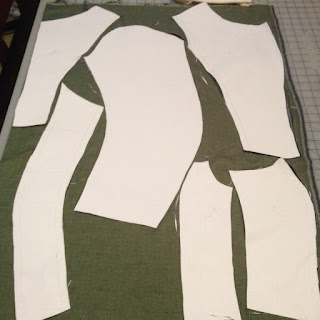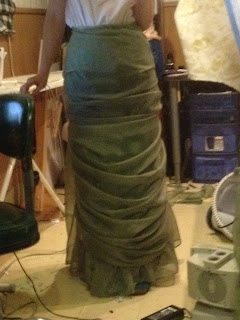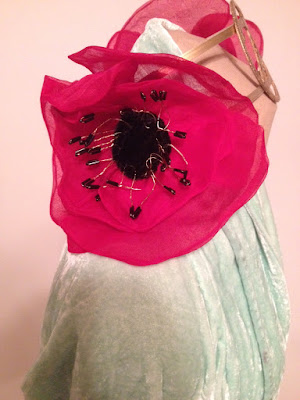Presenting my first made thing of 2017!
It's just a little handkerchief to practice some embroidery and blanket stitching. Plus, acorns are lucky, right?
Clothing Opus (and other stories)
Thursday, January 5, 2017
Monday, December 19, 2016
Victorian Christmas at the Painted Lady
I did it! It happened!
That is, everything except the sleeves, which were sacrificed in favor of quick pull-through puffs hand stitched on that morning. I still like it!
We drove down to Myrtle Creek to the fabulous Painted Lady B&B and Tearoom for a full (read: very full. Very very full) afternoon tea in a tea room delightfully crammed with antiques and knick-knacks for sale. As far as I can tell, this is the closest place to Eugene to get the full tea experience in an historic building (Wendi, the owner, puts it around 1910) and I can't recommend it highly enough. In between delicious courses, we played I Spy and took a few pictures.
Charlotte just finished finished an amazing 1890s tea gown from a certain well-known Harper's Bazaar fashion plate, and looked like a Christmas queen!
That is, everything except the sleeves, which were sacrificed in favor of quick pull-through puffs hand stitched on that morning. I still like it!
We drove down to Myrtle Creek to the fabulous Painted Lady B&B and Tearoom for a full (read: very full. Very very full) afternoon tea in a tea room delightfully crammed with antiques and knick-knacks for sale. As far as I can tell, this is the closest place to Eugene to get the full tea experience in an historic building (Wendi, the owner, puts it around 1910) and I can't recommend it highly enough. In between delicious courses, we played I Spy and took a few pictures.
| From thepaintedladybbtearoom.com |
And now more pictures:
Allll of the shirring. And puffs. And swags. And paniers.
This is in the bathroom because it was green.
I was trying for an awkward fashion-plate pose, I think it worked! (Isn't it so hard to know how to pose in gowns?)
Happy Victorian Christmas!
Friday, December 16, 2016
A Victorian Christmas Part 2, and Sleeves.
The last week has been characterized by a despondency relating directly to the systematic (temporary) demise of all my sewing machines, and the return of a faithful loaner. However, I have been saved by a Christmas Miracle, in the form of an early present from my Lovey Dove, who researched, saved, consulted, and bought me the nicest civilian machine I have ever owned.
I truly believe this Janome DC2014 is going to be a paradigm-changer for my sewing life. With an incredibly diverse and jam-proof machine, featuring an even-feed foot, one-step buttonholes, overcast options, and feed-dog adjustment, I was given the gift of extra weeks in the year (losing many to sewing machine frustration) and a pathway to cleaner, more professional sewing.
 |
| Bodice, front on the left and back on the right. |
First stages of skirt
I did a lot of studying of the late natural form/late bustle transitional period from 1880-1883, and wibbled a lot on what I wanted this skirt to convey. I decided to settle on the small perky bum and slim skirt of 1881.
Speaking of perky bums, I thought this addition to Truly Victorian's petticoat pattern really helped. For 1882-1883, I might add ruffles in the front as well, for that all-around, pre-bustle roundness.
 |
| In a reversal of the Early Natural Form silhouette (narrow hips, wide at the feet), the Late Natural Form is wider at the hips and narrower at the feet. |
Finally starting to look like something! Before filling in with paniers, puffs, and ruches. And lots of elastic, so I can actually walk in a skirt that slim. I'm quite sure they used elastic in the late Victorian era, I have a Godey's pattern that specifically calls for it.
As far as sleeves go, I wanted to do tight elbow sleeves that were completely shirred, with small elbow flounces. However, to save on time, I decided to reduce the number of gathering lines to create ruched mameluke sleeves, which I did not think were particularly period for the year. Imagine my surprise when I found actual images of puffed or ruched mameluke-type sleeves in fashion plates of the time!
 |
| Faux elbow puff on right |
 |
| Upper puffs on the left, lower puffs on the right. |
 |
| Definitely mamelukes on the left |
 |
Plus, the paperwhites are blooming. Happy Victorian Christmas!
Wednesday, November 30, 2016
A Victorian Christmas After All?
It seems that this fall/winter is the season that sees me finish projects I started last year at the same time. Which means the projects that I started this fall/winter will probably be finished next year. I can live with it!
When cleaning my sewing room the friday after Thanksgiving, fussy and discontented with all my current projects being in the mockup/fitting stage, I came across a natural form-era gown that I had painstakingly patterned, fit, and cut last year. I had put it to the side because it is an exercise in shirring, and I didn't feel ready for it until now.
It turns out, hand gathering is the perfect thing to do at the table by the fire with guests for the whole weekend. I based the gown on the fan-front bodice by Truly Victorian made to the lines of a long 1880 cuirasse bodice. It is in a sheer, moss-gold-green poly chiffon, which was almost too cheap to mention (it was leftover from wedding decor and I was broke) but I believe will give a good effect overall.
Experimenting with draping paniers.
The bright green underskirt/lining will be completely covered by the chiffon; oddly enough, this was the only backing that I felt brought out the 'true color' of the sheer fabric.
 |
| Tape has been stitched to the shirring in the back train where it isn't fully lined. |
My main design questions are the direction of shirring on the skirt: Vertical like this:

Or horizontal like this? (on the left)

OR horizontal with poofs like the one on the right below?

Honestly, I might just go with whatever seems less time consuming, since I now have the slightest hope of a new gown for this year's Victorian Christmas Tea on the 17th! (Can totally do this...)
Wednesday, November 16, 2016
What I've been up to lately...
Treating my dressform like a large doll
 |
| 1950s style petticoat over 18th c. Paniers |
Mocking up a turn-of-the-century princess gown
 |
| Tight sleeves with a slight head, and a tight bodice with as few seams as possible. What could go wrong? |
Trying out Norah Waugh's 1904 ribbon corset, and dying my own linings to match
Planning an evening gown
 |
| The one one the right? Mauve silk taffeta? |
Reading the very charming Tales Told in Holland, usually while sitting by the fire
And, you know, some other stuff. Toodles!
Tuesday, November 8, 2016
Ozma's Diadem
The fabrication of the iconic Diadem was no simple matter. The poppies were easy enough, I had dyed silk organza a bright red (redder than the photo) and formed the petals. The stamens were black beads twisted on gold colored wire and sewn to a black velvet pad. I made the stems by pulling upholstery cord through a silk bias tube.
For the center piece, I decided to go with Bronzclay, since I had experimented with it last year, and had all of the tools. If you haven't used precious metal clay before, it is amazing stuff. You roll it, mold it, stamp it, sculpt it, like a regular (albeit very sticky and finicky) clay, then you bake it in a kiln and it becomes metal. The finish is very matte after baking, the shine was achieved after an hour with a dremel and some jewelry-grade buffing oil. The bubbles and pits had to do, I think, with the firing: the piece was a little too big for the pan, and I might not have kneaded the air out enough to start.
The bands are simply corset boning painted gold. The centerpiece clips onto the bands using some prongs I set into the back, also made of clay. This worked way better than I would have thought.
Ta da!
Tuesday, October 25, 2016
Ozma of Oz
 |
| The Lost Princess of Oz (1916). Illustration by John R. Neill |
I had the chance this year to go to a Wizard of Oz themed Steampunk party in October. Being a minor Oz expert, and already having a green gown, I knew my role would be Ozma, Ruler of Oz.
Finished pictures now, I'll break down the costume and accessories in the next post!
Subscribe to:
Comments (Atom)



























